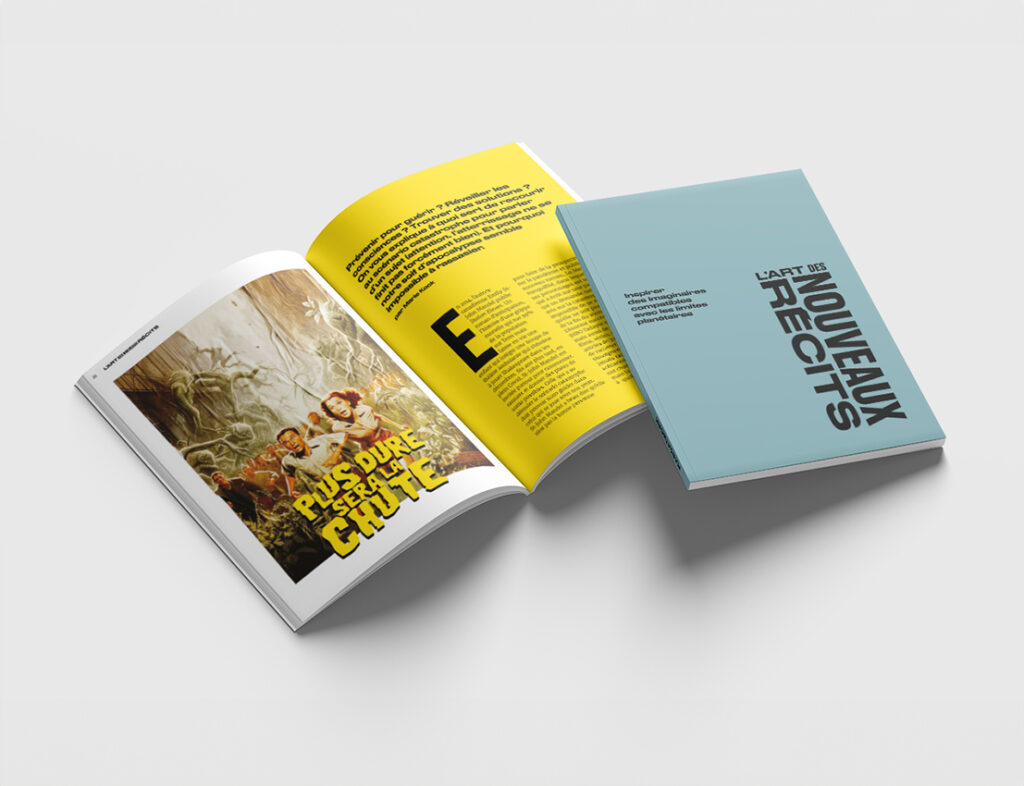The CSRD, or Corporate Sustainability Reporting Directive, will replace the NFRD from 2024. More demanding and ambitious, this new directive contributes to the rise of CSR, increasing the principle of accountability as well as its impact on companies and society. Sometimes perceived as a simple formality that companies must fulfill, or even as technocratic pressure, the CSRD is nevertheless a tool for assessment, preparation and transformation in the face of social, economic and climate issues.
What if we took advantage of this to create new stories?
Legislators, investors, suppliers, customers… All stakeholders are waiting for organizations to step up with increased requirements and collaborations conditioned by their CSR performance. Beyond its virtuous potential, mobilization and regulation, and in view of the growing expectations towards brands, the CSRD must be considered as a crucial axis of communication and a major statement by the company. But like any constraint, this new directive contains real opportunities. Moreover, even companies not legally constrained by the new directive are getting involved. Because if we take it on, CSR is a great opportunity for the company to tell its story.
Create new links
According to a CSR project manager from a large insurance group, “we cannot respond to the complexity of the systemic challenges of CSR without thinking about their globality, in cross-functional collaboration”. The key to a successful CSR report first involves close collaboration and a relationship of trust between the company’s experts, CSR teams, and communications, supported by a convinced management… “We have never had so many requests for proof of our actions and commitments”, says Barbara Schwartz, CSR Expert for Business Management at Orange Grand Sud Est.
When we know that bank loans or partnerships can be conditioned by an organization’s CSR performance, that they have a strong power over a brand’s image and that they can have an impact on consumption habits and therefore a company’s results, it is essential to bring your teams together around CSR issues.
Together, they can define priority research and analysis areas to gather relevant data, know how to interpret it, and make it intelligible. These new collaborations work to break down silos and blur the boundaries of a vast field of possibilities. These new collaborations will be all the more effective if the teams have been trained in the professions involved. CSR can be seen as a constraint. Acculturation of the company’s experts and communicators to CSR is therefore essential for their understanding of the issues surrounding reporting and to involve them in the process. For their part, CSR stakeholders and experts must also be trained in communication issues and techniques to be able to identify priority areas and produce intelligible results.
“CSR requires everyone to review their practices and establish new modes of collaboration, both within the company and outside, with a view to coalition and co-construction,” summarizes Anna Marion Lashermes, Strategy & Communication Manager at Yves Rocher. Climate Fresco, Advertising Fresco, Low Carbon Marketing and Communication Fresco*, but also immersion within teams, workshops and dedicated training are all good tools to raise awareness among teams about the challenges of the different professions involved.
Take charge of the subject
Extra-financial statements are dense reporting tools. Their production requires expertise, resources, and time. They provide such detailed knowledge of the company that it would be a shame not to exploit it.
At Yves Rocher, this was the starting point for a desire to make the brand’s CSR strategy known in a concrete and transparent way. To make it readable, the brand focused on 10 commitments and ambitions accompanied by their corresponding proofs and actions. The mobilization of the teams gave rise to an online booklet, developed in such a way as to be understood by as many people as possible. “We wanted it to be close to consumers, with tools to help them change their habits,” explains Anna Marion-Lashermes. “It provides practical advice for adopting new, more responsible actions in everyday life, and limiting plastic consumption in the bathroom, for example.”
It is the same desire for storytelling that led the Orange group to add a social component dedicated to issues of diversity and neuro-accessibility to its report. The telecommunications company has also published “IoT for green”, a white paper that deciphers how the uses and needs of companies are directly linked to the CSR commitments made by managers. Having recently become a mission-driven company, the Marseille clothing brand Sessùn took the opportunity to communicate very widely, via its newsletter, on its purpose (“Making the journey even more beautiful than the destination”) and on its approach.
Downloadable via the brand’s website, the CSR report of Sessùn highlights support for local sectors, recycling, supervised practices, the choice of materials and French partners. The CSR report embodies the company’s approach, which perpetuates the model and allows for operational, financial and legal pivots that we know about, but also narrative ones. However, be careful with the indigestible list of data and the sums of commitments pulled out of a hat, without proof and too difficult to link to the company’s personality. What works in these examples is the ability of these companies to use the DPEF (Extra-Financial Performance Declaration) in a relevant way to renew their story while remaining faithful to their benchmarks and beliefs.
Write new stories
This is where working with an agency can be decisive. “We were very well prepared, and knew exactly what we wanted,” says Anna Marion-Lashermes from Yves Rocher. “We had identified the themes and proof of our commitments, carried out a lot of research and were therefore very well-informed. Marsatwork was the ideal partner to challenge us and support us in developing a more embodied story, through the brand, its employees and partners, in a document that was accessible to all and educational.” The idea is to avoid a list of commitments that sound random, but rather to match the strengths and weaknesses of the brand to give meaning, and tell a story that it can make its own. For Anna Marion-Lashermes, Yves Rocher knew how to “dare to think outside the box, give itself a space of freedom to create new stories about business transformation”.
For the manufacturer of plant-based cosmetics, a return to its Breton roots was essential. The booklet adapted from the company’s CSR report looks back at the 9 emblematic plants that it has historically used, and which grow in Brittany, in its 60 hectares of organic fields cultivated using agroecology. A story anchored in the brand’s values, for better employee buy-in.
And consumers are increasingly demanding complex and reliable information – data that was previously reserved for corporate and/or BtoB communications.
Dare to be vulnerable, of course
Here, there is no question of adopting a discourse that could be transposed to any other actor. At best, it would be of no interest. At worst, the approach would be counterproductive and could be accused of greenwashing*. The speech must be transparent. While the good points must be highlighted, they cannot do without proof, and the areas for improvement cannot be hidden. “The framework is so regulated that each environmental claim must be demonstrated, and stakeholders want to receive reliable elements. We wouldn’t risk beautifying the bride” explains our CSR officer from a large insurance group.
According to Barbara Schwartz, CSR Expert, Orange Grand Sud Est Business Department at Orange, “vulnerability can be a strength. Taking responsibility for areas that need improvement is often seen as a sign of trust”. The young woman explains that, during webinars on responsible mobile phones organized by the brand, she does not hesitate to explicitly discourage the purchase of new devices and direct those who need them towards a responsible purchase.
Anna Marion-Lashermes, Brand Strategy & Communication Manager at Yves Rocher advises to “stay humble and factual”, and adds that “we cannot put forward weak points without proposing avenues for improvement to address them”. According to Dan Geiselhart, founder of the media Climax, “we must above all avoid highlighting ‘small actions’ that could hide larger blind spots.” Hence the importance of preparatory work with teams of CSR experts and communicators, where each issue, each problem, each piece of evidence is identified. Dan Geiselhart also recommends transparency and welcomes the approach of Patagonia which, like Barbara Schwartz of Orange during the webinars she moderates, dares to advise its consumers not to buy new products.
Will CSR reports soon turn into an anti-purchase guide? On the occasion of the last Black Friday, the advertising campaign of the Ministry of Ecological Transition created controversy, featuring a “dealer” and his customer, not without provoking the anger of traders… and that of the Minister of the Economy Bruno Lemaire, who is well-versed in the dialectic of ‘at the same time’. “It’s a clumsy campaign,” he judged. “I deeply believe in sobriety. I believe in incentives, not guilt trips.” A position that could serve as advice to those who would like to embark on their next CSR report.
A report, but who will read it?
As a communicative report, the company’s CSR report must serve as a tool for awareness, understanding and commitment within teams. Formalizing its presentation can give substance to the adventure.
It is with this in mind that Orange’s Financial Communications Department has set up a media plan involving Christel Heydeman, the group’s CEO, in order to formalize the results of its latest DPEF. Yves Rocher is also considering a PR and event strategy to involve the general public in its approach.
Green more effort
Promoting your CSR actions deserves to make efforts… CSR! Because it is out of the question to assert your ecological commitments on a polluting medium, printed on the other side of the planet and distributed massively, eco-design and the rules of responsible communication (see the recommendations of ADEME) are essential. As is the calculation of the carbon weight of any action, a new obligatory step in marketing and communication. Anti-greenwashing is a matter of consistency.
*See The Art of Anti-Greenwashing (Marsatwork Editions). Greenwashing refers to any form of misleading or fraudulent communication about the ecological performance of a product, service or company.
**The Low Carbon Marketing and Communication Fresco® is an offer designed and offered exclusively by Marsatwork. The agency has also developed Fresk’It, a participatory workshop that invites each company to build its own fresco.
Download your copy


